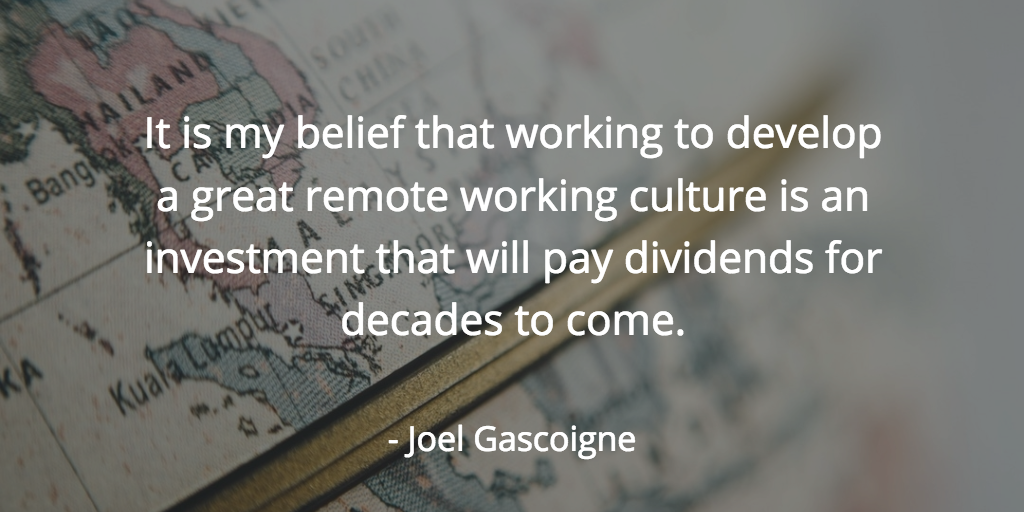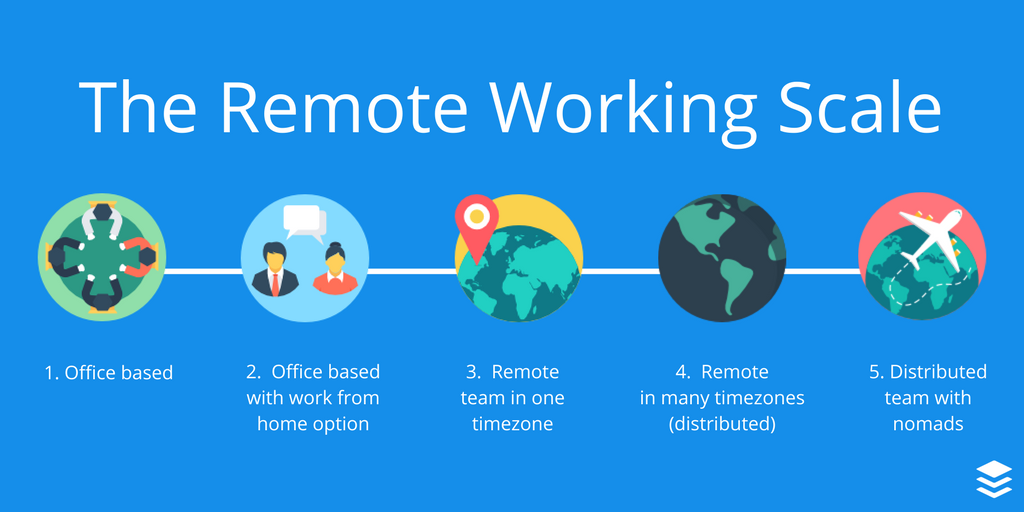I’ve recently found myself reflecting a lot on being a distributed team and the nature of a company where the team works from remote locations to accomplish our work.
Scaling remote working has been a challenge as the team has grown. Remote companies are still relatively rare, and therefore all of us who are choosing to have a remote-friendly culture need to do two things:
- Work through the normal challenges of growing as a company and as a team
- Put time into figuring out how remote can scale, where there is no real pre-existing playbook
One of the significant commitments we’ve recently made at Buffer is to approach our company growth goals in a long-term fashion, staying true to our culture of remote working. This means we are deliberately making time to try to scale remote working, even if this may at times feel like it comes at the expense of short-term financial growth.
It is my belief that working to develop a great remote working culture is an investment that will pay dividends for decades to come. If we can make this work over the long-term, we set the company up for many significant advantages and great freedom for us as a team.

The 5 Points on the Scale of Remote Working
In my reflections, I realized that I see remote working as a scale, with five points along the spectrum from “not remote” to “fully distributed”.

1. Office-based culture (not remote)
At the far end of the spectrum, we have what is today perhaps the most typical working environment for companies. In this model, you have your whole team in one or more offices.
These companies have set working hours that are strict or loosely enforced. Employees work from the office all day and don’t have much flexibility in their day. They also wouldn’t be able to choose their work environment and to focus on the space they find themselves the most productive in.
Of course, office-based environments are also awesome for a whole bunch of reasons. People more naturally have close bonds and friendships forming. They can whiteboard and brainstorm, which is often very productive. If there are people who are junior in their role at the company, they can very readily and easily get help so they don’t get stuck.
2. Office-based with a work-from-home option
Next on the scale are companies which operate from a single office and have started to give team members the option to work from home one or more days per week. This is a great start and perhaps a perfect way to start to experiment with a remote working culture.
This small degree of remote-friendliness will already test the culture and require a few key changes to how work happens within a team. For example, on those days that team members are working from home, the team will need to mostly communicate through email, chat tools, or some other means than the more traditional face-to-face methods, which are sometimes more relied on in an office environment.
One key challenge when starting to experiment with this setup is avoiding the people who work from home feeling left out of discussions that lead to key decisions. With most of the team in one place and a few people not in the office, it’s easy for the people at home to feel like second-class citizens.
3. A remote team, in a single time zone
This is where things start to get more truly remote — although some remote companies do still choose to have the team mostly in one time zone or very few largely overlapping time zones.
This is a truly remote setup, so the way work happens is different than a team based in an office. Text-based communication and collaboration tools will come in here.
At the same time in this setup, there are still a lot of hours of overlap, if not full overlap, with everyone on the team. So at least the team can rely on someone being available when a teammate needs to get work done. This means a lot of the day-to-day work can still be done in a synchronous fashion and work well.
4. A worldwide remote team spread across numerous time zones
A step further is to have a team spread across different time zones — a setup where asynchronous collaboration becomes even more vital. They are likely just to have a few hours of overlap with other people on the team. This setup requires a little more structure to make communication and collaboration efficient.
Sometimes companies set up this way will choose to concentrate certain roles in the same time zone. Other times, it will be a completely location-independent setup. In either case, there are generally team members staying permanently in their location, for a long duration of time. So the company can create some consistency surrounding the setup of each team and can set up some forms of synchronous communication at the times of overlap.
The challenges with a fully remote setup like this are numerous; however, there are also many benefits. One key benefit is around-the-clock coverage of customer support or engineering.
5. A fully distributed team with nomadic team members
In my mind, this is the most extreme case of remote working. It’s a fully remote team where some of the members of the team are nomadic and traveling.
Our distributed team setup at Buffer is a result of our vision to create a workplace of the future and around our value to live and work smarter. This final point on the scale is the ultimate level I am currently striving for us to reach.
Currently, we see some challenges in reaching this level of freedom for team members, especially while also having a collaboration system that can be efficient for this setup. A key milestone in my mind is that work continues regardless of people moving locations. Of course, it should be kept in mind that moving to a new place can affect productivity. I do, however, believe that there is a way team collaboration can happen, where regardless of the productivity challenges a team faces, work can happen the exact same way, no matter a teammate’s location. This is what is truly needed to be able to work efficiently with nomadic people in the team.
I believe open source can be a great inspiration for the kind of asynchronous collaboration that is core to this setup. Synchronous chat tools are problematic. At the same time, to cultivate culture and create bonds, synchronous chat tools and video calls are effective here, too. The key, it seems, is to separate “how work happens” from those synchronous communications.
Over to You
I’d love to hear about your perspectives on remote work in the comments.
- Do you do remote working at your company?
- Which level are you at, or do you see yourself a different level I’ve not covered here?
- What do you think is worth striving for?
This article originally appeared on Joel.is.
Icons made by Freepik, Flat Icons, VectorsMarket, Maxim Baskinski and Popcorn Arts.
Try Buffer for free
190,000+ creators, small businesses, and marketers use Buffer to grow their audiences every month.




